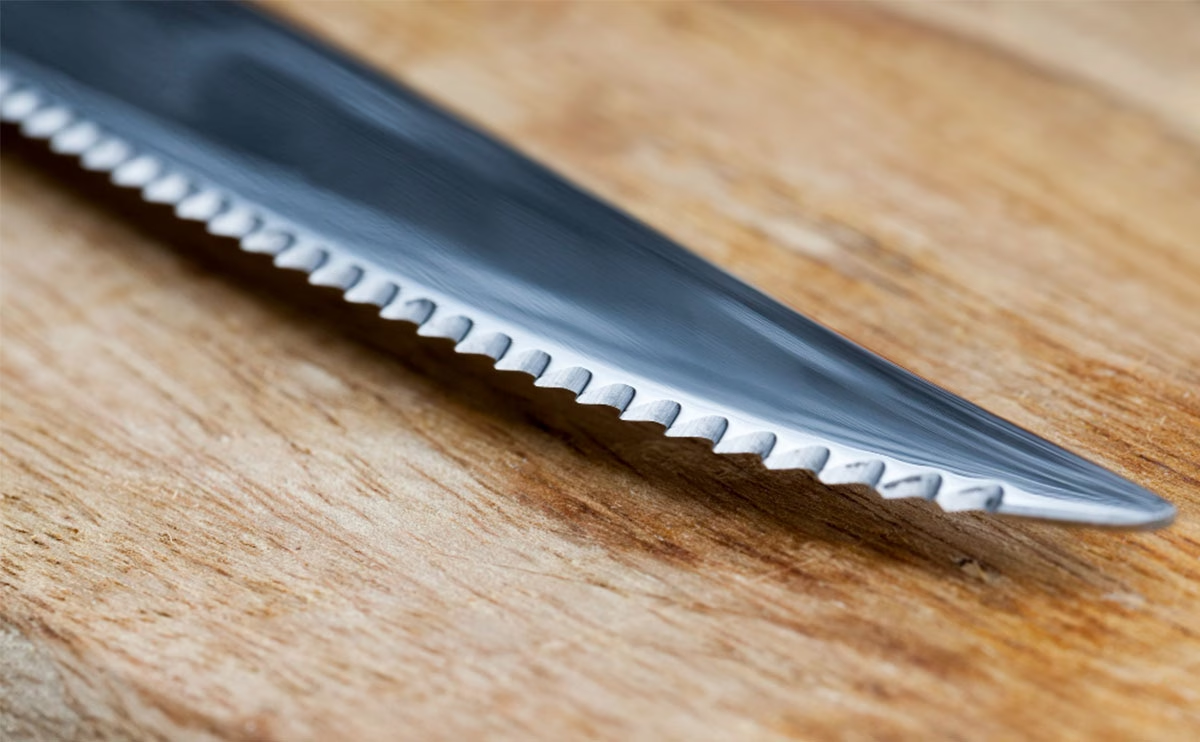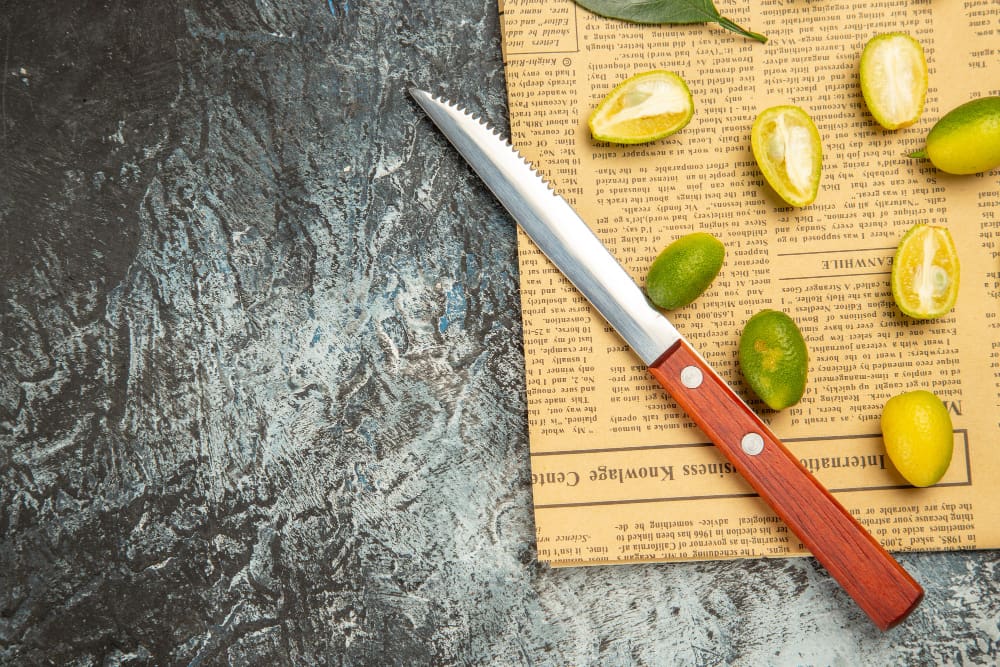How to Sharpen a Serrated Knife: A Complete Guide

Serrated knives are indispensable tools in any kitchen, designed to make precise cuts through tough exteriors while preserving the delicate interiors of foods like bread, tomatoes, and meats. However, like all tools, these knives will eventually lose their sharpness, making it more difficult to cut cleanly and efficiently. Learning how to sharpen a serrated knife is crucial to maintain its performance and extend its lifespan.
Table of Contents
What is a Serrated Knife?
A serrated knife features a blade with a series of small, tooth-like edges, resembling a saw. These teeth allow the knife to cut through foods with tough exteriors, such as crusty bread, while minimizing damage to the softer interior. While serrated knives are excellent for specific tasks, they require a different sharpening method than traditional straight-edged knives.

Types of Serrated Knives
· Bread Knife: Typically the most common type, used to slice through crusty bread without crushing the soft inside.
· Tomato Knife: A smaller serrated knife with fine teeth for cutting delicate fruits and vegetables.
· Steak Knife: A serrated knife designed for cutting through meat, often with a shorter blade and more aggressive teeth.
Why Sharpening a Serrated Knife is Important
Sharpening a serrated knife restores its cutting efficiency, making food preparation smoother and more accurate. A dull serrated knife is harder to use, especially for cutting through tough-skinned fruits, vegetables, or crusty bread. A sharp knife ensures cleaner, more precise cuts and minimizes the chance of accidents due to increased pressure while cutting.
Benefits of Sharpening a Serrated Knife
· Easier cutting: Sharp serrations glide through foods, saving you time and effort.
· Better control: A sharp knife allows for better precision, leading to more controlled cuts.
· Extended lifespan: Regular sharpening prolongs the life of your knife, saving money in the long run.
Consequences of a Dull Knife
· Increased effort: You’ll have to apply more force to make a cut, which can be dangerous.
· Uneven cuts: A dull knife can lead to jagged, uneven slices.
· Risk of food damage: Dull serrations can crush delicate foods instead of slicing through them smoothly.
Common Misconceptions About Serrated Knives
There are a few myths that often discourage people from sharpening their serrated knives. Some believe these knives never need sharpening because they have multiple edges. However, this is untrue. While serrated knives do hold their edge longer than straight knives, they still dull over time. Additionally, some believe that sharpening serrated knives is impossible, but with the right tools and techniques, it’s a straightforward task.
When to Sharpen a Serrated Knife
Knowing when to sharpen your serrated knife is essential to maintaining its performance. You should sharpen it when it shows signs of dullness or damage.
Recognizing Dull Teeth
The most obvious sign of a dull serrated knife is difficulty in cutting. If the knife struggles to cut through tough skins or crusty surfaces, it’s time to sharpen. Look for teeth that appear rounded or worn down.
Frequency of Sharpening
The frequency of sharpening depends on the frequency of use. If you use your serrated knife regularly, you may need to sharpen it every 6–12 months. For knives that are used less frequently, once a year may be sufficient.
Tools Needed to Sharpen a Serrated Knife
Sharpening a serrated knife requires specific tools designed for serrations. Regular sharpening tools used for straight-edged knives aren’t effective for serrated blades.
Sharpening Rods and Stones
These are the most common tools for sharpening serrated knives. A sharpening rod, often ceramic or diamond-coated, is used to hone the edges of each tooth. Sharpening stones can also be used to restore the edge.
Serrated Knife Sharpening Kits
Some specialized kits are available for serrated knives. These kits include tapered rods or tools designed specifically to fit the serrations, making the sharpening process more precise and efficient.
Step-by-Step Guide to Sharpen a Serrated Knife
Sharpening a serrated knife requires careful attention to detail to maintain the sharpness of each individual serration. Follow these steps to restore your knife’s cutting performance.
Preparing Your Serrated Knife for Sharpening
Before you begin sharpening, ensure that the knife is clean and free from any dirt or food particles. Here’s how to prepare:
1. Clean the Knife: Wash your serrated knife with warm, soapy water and dry it completely. This helps you avoid grinding any food residue into the blade during the sharpening process.
2. Set Up Your Workspace: Choose a stable, well-lit surface for sharpening. A countertop or sturdy table is ideal. Lay down a towel or non-slip mat to prevent the knife from sliding while you work.
3. Wear Protective Gear: It’s a good idea to wear gloves to protect your hands from the sharp teeth of the serrated edge. Also, ensure you have a firm grip on the knife.
Positioning the Knife Correctly
To sharpen a serrated knife properly, it’s essential to hold it at the correct angle and position.
1. Grip the Knife Firmly: Hold the handle of the knife with your dominant hand and place your other hand lightly on the blade to guide it.
2. Position the Knife for Sharpening: Hold the knife so that the serrated edge is facing you, and the flat side is up. This ensures that you’ll focus on sharpening the serrated edge without damaging the flat side.
3. Angle of the Knife: The sharpening angle for serrated knives is typically around 20 degrees. Try to maintain this angle as you move the sharpening tool along the teeth.
Sharpening the Serrated Knife
Sharpening a serrated knife is different from sharpening a straight-edged knife because you need to focus on the individual teeth. Here’s how to sharpen them:
1. Focus on Each Serration: Start by sharpening one serration at a time. Run the sharpening tool along the edge of the tooth, following the natural curve of the serration.
2. Sharpen Consistently: Apply even pressure to ensure each tooth is sharpened uniformly. If one serration is sharper than the others, the knife will not cut as effectively.
Using a Sharpening Rod
A sharpening rod is the most common tool for serrated knife sharpening. Follow these steps to use it:
1. Select the Right Rod: Choose a rod that fits the size of the serrations. A tapered ceramic or diamond-coated rod is ideal for serrated knives.
2. Insert the Rod into the Serrations: Place the sharpening rod into the valley of each serration. The rod should fit snugly in the space between the teeth.
3. Move the Rod Back and Forth: Gently move the rod back and forth along the serration’s edge. Focus on maintaining a consistent angle to avoid damaging the teeth.
4. Repeat for Each Serration: Continue the process for every serration on the blade. Work your way from the base to the tip of the knife.
Using a Sharpening Stone
A sharpening stone can also be used to restore the edge of a serrated knife. Here’s how to do it:
1. Select a Suitable Sharpening Stone: Choose a stone with a fine grit, preferably between 1000 and 3000, to sharpen the serrated edge without removing too much material.
2. Angle the Knife Correctly: Hold the knife at the same 20-degree angle, and ensure that the flat side of the blade is facing the stone.
3. Sharpen the Serrations: Position the serrated edge of the knife on the stone and gently move it in a circular or back-and-forth motion to sharpen each individual serration.
4. Use Light Pressure: Apply light pressure to avoid over-sharpening or damaging the serrations. Focus on sharpening each tooth evenly.
By following these steps, you can effectively sharpen each serration and restore the cutting performance of your serrated knife.
Maintaining a Sharpened Serrated Knife
Once your knife is sharpened, it’s essential to maintain it to keep it sharp longer.
Proper Storage of Your Knife
Store your serrated knife in a knife block or protective sleeve to prevent damage. Avoid leaving it loose in a drawer where it could get nicked or chipped.
Regular Maintenance Practices
Occasionally hone your serrated knife using a honing rod to keep the serrations aligned. Regular use will keep the teeth sharp for longer, delaying the need for major sharpening.
Alternative Methods for Sharpening Serrated Knives
If you don’t have the tools to sharpen your serrated knife manually, there are other options.
Using Electric Knife Sharpeners
Some electric sharpeners come with attachments for serrated knives. These sharpeners can quickly and efficiently restore the edge of a serrated knife, although they are typically more expensive than manual tools.
Professional Sharpening Services
If you’re unsure how to sharpen your knife or if it’s too damaged, consider sending it to a professional sharpener. They have the right tools and expertise to restore your serrated knife to its original sharpness.
Troubleshooting Sharpening Issues
Sometimes sharpening doesn’t go as planned. Here are some common issues and solutions:
Uneven Sharpening
If the serrations are sharpened unevenly, check the angle of the sharpening rod or stone. Make sure you’re applying even pressure to each serration.
Damaged Teeth
If some teeth are chipped or broken, you may need to replace the knife, as there may be no way to effectively sharpen a severely damaged blade. Alternatively, a professional sharpening service can help.
Frequently Asked Questions
1. How Do You Know When a Serrated Knife is Sharp?
A sharp serrated knife should glide through tough exteriors effortlessly. If it’s still struggling, it needs sharpening.
2. Can You Sharpen a Serrated Knife Without a Special Tool?
You can use a regular sharpening rod, but it’s best to use a rod or stone specifically designed for serrated knives for better results.
3. Can a Serrated Knife Be Sharpened Too Much?
Yes, sharpening a serrated knife too often can wear down the teeth, reducing its effectiveness. Only sharpen when necessary.
4. Is It Safe to Sharpen a Serrated Knife at Home?
Sharpening a serrated knife at home is safe as long as you use the proper tools and techniques. Always work slowly and carefully.
Conclusion
Sharpening a serrated knife is an essential skill to keep it performing well. By using the right tools and techniques, you can maintain the sharpness and efficiency of your serrated knives for years to come. Regular sharpening, proper storage, and consistent maintenance will ensure your knives stay in top shape, and ready for any kitchen task.
